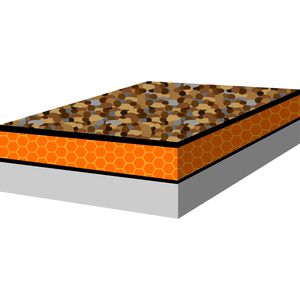
- Building & Construction
- Insulation and sealing
- Thermal insulation
- CARLISLE Construction Materials GmbH
Thermal insulation Fpolyisocyanurate (PIR) foamrigid panelfor flat roofs
Add to favorites
Compare this product
Characteristics
- Type
- thermal
- Material
- polyisocyanurate (PIR) foam
- Format
- rigid panel
- Use
- for flat roofs, for green roofs
- Technical characteristics
- high-performance
- Options
- with vapor barrier, lightweight
- Thermal conductivity
0.024 W/(m.K)
- Thermal resistance
Min.: 2.7 m²K/W
Max.: 5.45 m²K/W
- Thickness
Min.: 60 mm
(2.36 in)Max.: 120 mm
(4.72 in)
Description
CARLISLE® Thermal Insulation-F is a high performance foil faced insulation board specifically designed for use with single ply EPDM membranes RESITRIX® and HERTALAN®, in both new build and refurbishment applications.
This high performance rigid PIR foam board is suitable for use in warm flat roofs under our mechanically fixed single-ply membrane systems. With dimensional stability, the board benefits from the high compressive strength that exceeds 150kpa at yield. It is also suitable for loads associated with pedestrian maintenance traffic on the roofing systems.
PRODUCT FEATURES & BENEFITS
• High performance rigid PIR foam board
• High compression strength
• Manufactured using a blowing agent with zero ODP (ozone depletion potential) and low GWP (global warming potential)
• Has a low thermal conductivity value (0.022 W/mK) providing an enhanced thermal performance
• Compression strength exceeds 150kPa at yield
• Has Class 1 fire performance in accordance with BS 476
• Will not degrade or deteriorate if exposed to moisture, therefore maintaining its thermal performance
• Lightweight board
• Easy handling and installation
Catalogs
Other CARLISLE Construction Materials GmbH products
CCM Thermal Insulation
Related Searches
- Insulation
- Panel insulation
- Thermal insulation
- Waterproofing membrane
- Synthetic insulation
- Roll waterproofing membrane
- High-performance insulation
- Polymer waterproofing membrane
- Sealant
- Protection waterproofing membrane
- Roof insulation
- Roof waterproofing membrane
- Rigid insulation panel
- Lightweight insulation
- Insulation with vapor barrier
- Asphalt waterproofing membrane
- Flexible waterproofing membrane
- Elastic sealant
- Vapor barrier
- Adhesive waterproofing membrane
*Prices are pre-tax. They exclude delivery charges and customs duties and do not include additional charges for installation or activation options. Prices are indicative only and may vary by country, with changes to the cost of raw materials and exchange rates.








